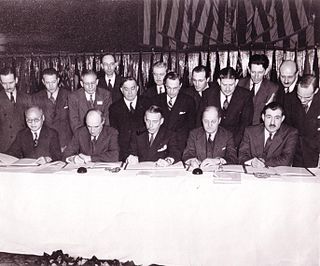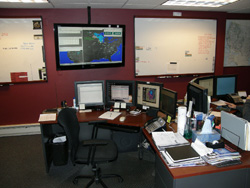Related Research Articles

A traffic alert and collision avoidance system (TCAS, pronounced TEE-kas), also known as an Airborne Collision Avoidance System (ACAS), is an aircraft collision avoidance system designed to reduce the incidence of mid-air collision (MAC) between aircraft. It monitors the airspace around an aircraft for other aircraft equipped with a corresponding active transponder, independent of air traffic control, and warns pilots of the presence of other transponder-equipped aircraft which may present a threat of MAC. It is a type of airborne collision avoidance system mandated by the International Civil Aviation Organization to be fitted to all aircraft with a maximum take-off mass (MTOM) of over 5,700 kg (12,600 lb) or authorized to carry more than 19 passengers. CFR 14, Ch I, part 135 requires that TCAS I be installed for aircraft with 10-30 passengers and TCAS II for aircraft with more than 30 passengers. ACAS/TCAS is based on secondary surveillance radar (SSR) transponder signals, but operates independently of ground-based equipment to provide advice to the pilot on potentially conflicting aircraft.

The European Union Aviation Safety Agency (EASA) is an agency of the European Commission with responsibility for civil aviation safety in the European Union. It carries out certification, regulation and standardisation and also performs investigation and monitoring. It collects and analyses safety data, drafts and advises on safety legislation and co-ordinates with similar organisations in other parts of the world.

The Convention on International Civil Aviation, also known as the Chicago Convention, established the International Civil Aviation Organization (ICAO), a specialized agency of the United Nations charged with coordinating international air travel. The Convention establishes rules of airspace, aircraft registration and safety, security, and sustainability, and details the rights of the signatories in relation to air travel. The convention also contains provisions pertaining to taxation.
An Aviation Medical Examiner or Aero-medical Examiner (AME) is a physician designated by the national aviation authority and given the authority to perform flight physical examinations and issue aviation medical certificates. AMEs are practitioners of aviation medicine, although most are also qualified in other medical specialties.

The European Organisation for the Safety of Air Navigation, commonly known as Eurocontrol, is an international organisation working to achieve safe and seamless air traffic management across Europe. Founded in 1963, Eurocontrol currently has 41 member states with headquarters in Brussels, Belgium. It has several local sites as well, including an Innovation Hub in Brétigny-sur-Orge, France, the Aviation Learning Centre (ALC) in Luxembourg, and the Maastricht Upper Area Control Centre (MUAC) in Maastricht, the Netherlands. The organisation employs approximately two thousand people, and operates with an annual budget in excess of half a billion euros.

A flight dispatcher assists in planning flight paths, taking into account aircraft performance and loading, enroute winds, thunderstorm and turbulence forecasts, airspace restrictions, and airport conditions. Dispatchers also provide a flight following service and advise pilots if conditions change. They usually work in the operations center of the airline. In the United States and Canada, the flight dispatcher shares legal responsibility with the commander of the aircraft.
In aviation, an Aeronautical Information Publication is defined by the International Civil Aviation Organization as a publication issued by or with the authority of a state and containing aeronautical information of a lasting character essential to air navigation. It is designed to be a manual containing thorough details of regulations, procedures and other information pertinent to flying aircraft in the particular country to which it relates. It is usually issued by or on behalf of the respective civil aviation administration.
The Future Air Navigation System (FANS) is an avionics system which provides direct data link communication between the pilot and the air traffic controller. The communications include air traffic control clearances, pilot requests and position reporting. In the FANS-B equipped Airbus A320 family aircraft, an Air Traffic Services Unit (ATSU) and a VHF Data Link radio (VDR3) in the avionics rack and two data link control and display units (DCDUs) in the cockpit enable the flight crew to read and answer the controller–pilot data link communications (CPDLC) messages received from the ground.
PANS-OPS is an air traffic control acronym which stands for Procedures for Air NavigationServices – Aircraft OPerationS. PANS-OPS are rules for designing instrument approach and departure procedures. Such procedures are used to allow aircraft to land and take off when instrument meteorological conditions (IMC) impose instrument flight rules (IFR).
System Wide Information Management (SWIM) is a global Air Traffic Management (ATM) industry initiative to harmonize the exchange of Aeronautical, Weather and Flight information for all Airspace Users and Stakeholders. SWIM is an integral part of the International Civil Aviation Organization (ICAO) Global Air Navigation Plan (GANP). The GANP defines 4 Performance Improvement Areas (PIA), SWIM resides in PIA 2: Globally interoperable systems and data, where its implementation is further defined in Aviation System Block Upgrades (ASBU) B1-SWIM and B2-SWIM. ASBU B1-SWIM defines SWIM as a “a net-centric operation where the air traffic management (ATM) network is considered as a series of nodes, including the aircraft, providing or using information.” it goes on to say “The sharing of information of the required quality and timeliness in a secure environment is an essential enabler to the ATM target concept.”
The Aeronautical Information Service, or AIS is a service established in support of international civil aviation, whose objective is to ensure the flow of information necessary for the safety, regularity, and efficiency of international air navigation.
The English Language Proficiency Test (ELPT) was the name of a SAT II last administered in January 2005. It was a one-hour multiple choice test given on English language proficiency by The College Board. A student whose native language was not English could have chosen to take this test instead of or in addition to Test of English as a Foreign Language (TOEFL) for college entrance depending upon requirements of the schools in which the student was planning to apply. Until 1994, the SAT II's were known as Achievement Tests. The ELPT assessed both the understanding of spoken and written standard American English and the ability to function in a classroom where English is spoken. The test was intended for students whose best language was not English; who attend U.S. high schools, or who had studied in an international school where courses were taught in English; had completed two to four years of English language instruction in an English as a Second Language program or in English enrichment courses; or students who spoke a language other than English at home or work. It was scored on a scale of 901 to 999.
Medical certifications for aircraft pilots are specified by the International Civil Aviation Organization (ICAO). ICAO sets standards and recommended practices (SARPS), which are specified in Annex 1 to the Convention on International Civil Aviation.
Language assessment or language testing is a field of study under the umbrella of applied linguistics. Its main focus is the assessment of first, second or other language in the school, college, or university context; assessment of language use in the workplace; and assessment of language in the immigration, citizenship, and asylum contexts. The assessment may include listening, speaking, reading, writing, an integration of two or more of these skills, or other constructs of language ability. Equal weight may be placed on knowledge and proficiency, or greater weight may be given to one aspect or the other.
A civil aviation authority (CAA) is a national or supranational statutory authority that oversees the regulation of civil aviation, including the maintenance of an aircraft register.

Aviation communication refers to the conversing of two or more aircraft. Aircraft are constructed in such a way that make it very difficult to see beyond what is directly in front of them. As safety is a primary focus in aviation, communication methods such as wireless radio are an effective way for aircraft to communicate with the necessary personnel. Aviation is an international industry and as a result involves multiple languages. The International Civil Aviation Organization (ICAO) deemed English the official language of aviation. The industry considers that some pilots may not be fluent English speakers and as a result pilots are obligated to participate in an English proficiency test.

The aeronautical fixed service (AFS) is a telecommunication service between specified fixed points provided primarily for the safety of air navigation and for the regular, efficient and economical operation of air services. The AFS is provided by voice and data networks, including AFTN, AMHS and CIDIN.
TOEFA is the acronym for the Test of English for Aviation, that was the first worldwide examination presented by its author William Aranda, PhD, from Peru, at the International Aviation Language Symposium (IALS) organized by the International Civil Aviation Organization ICAO) in Montreal, Canada, in September 2004. It was validated with air traffic controllers from Nicaragua, Panama, Bolivia and Peru and with pilots of Peru and Greece.

Estonian Air Navigation Services, abbreviated as EANS, is a modern, rapidly developing company operating under the auspices of the Ministry of Economic Affairs and Communications of the Republic of Estonia. It is a business entity, the major function of which is to provide services to air traffic in accordance with international standards as well as to ensure flight safety in Tallinn Flight Information Region. The sole owner of the company shares is the Republic of Estonia.
English Language Proficiency for Aeronautical Communication Test (ELPAC) is a EUROCONTROL test for aeronautical communication designed to assess ICAO English Language Proficiency for pilots and air traffic controllers, and reflects the range of tasks undertaken in air traffic control and pilot communications. The test focuses on language proficiency, not operational procedures.
References
- 1 2 3 4 "Status of English Language Standard for Use in Civil Aviation" (PDF). International Civil Aviation Organization. April 2003. Retrieved November 8, 2013.
- ↑ "Aviation English Research Project: Data analysis findings and best practice recommendations An independent research report commissioned by CAA" (PDF). Civil Aviation Authority (UK). March 2017. Retrieved April 13, 2017.
- ↑ Li, Yuting (May 20, 2016). "Civil Aviation English for Pilots: An English Air-ground Communication Course Based on Simulating Videos". Master's Projects and Capstones.
- ↑ "ELPAC. English Language Proficiency for Aeronautical Communication leaflet" (PDF). Eurocontrol. Retrieved November 14, 2019.
- ↑ "ICAO Recognized Tests". International Civil Aviation Organization. Retrieved November 14, 2019.
- ↑ "Manual on the Implementation of ICAO Language Proficiency Requirements (Doc 9835)" (PDF) (2 ed.). International Civil Aviation Organization. 2010. Retrieved November 14, 2019.
- 1 2 "CentralExam Test for Aviation English". 2024.